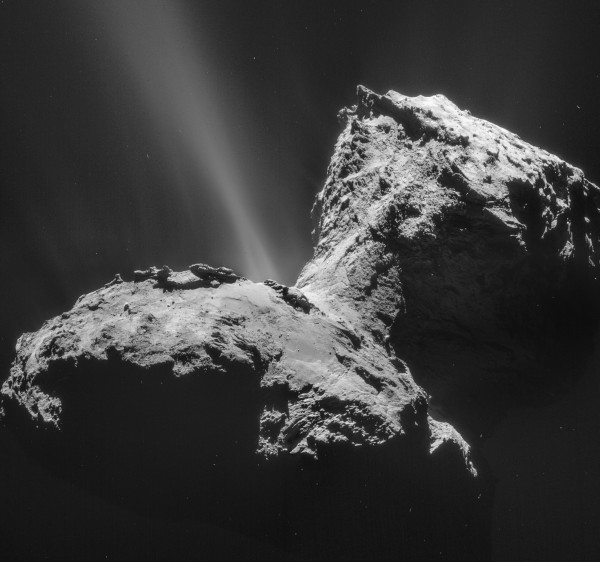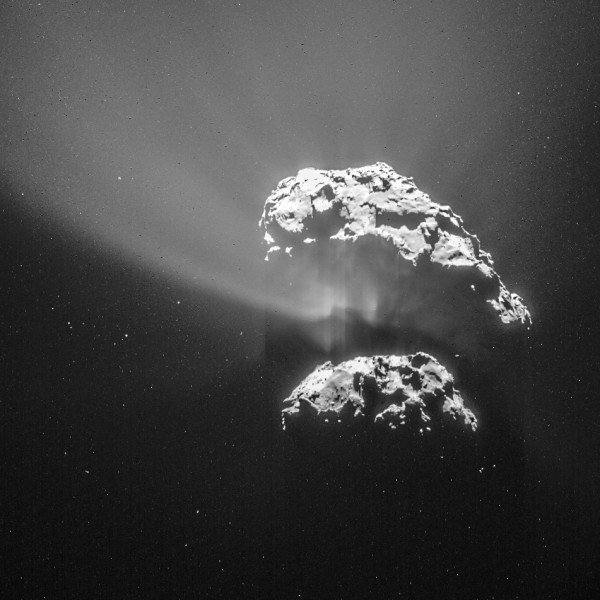“In the year 1456 … a Comet was seen passing Retrograde between the Earth and the sun… Hence I dare venture to foretell, that it will return again in the year 1758.” -Edmond Halley
When ESA's Rosetta mission "caught" its target, Comet 67P/Churyumov-Gerasimenko in August, 2014, one of its main science goals was to watch the comet become active from up close.
 Image credit: ESA/Rosetta/NAVCAM — CC BY-SA IGO 3.0, via http://www.esa.int/spaceinimages/Images/2015/02/Comet_on_31_January_201….
Image credit: ESA/Rosetta/NAVCAM — CC BY-SA IGO 3.0, via http://www.esa.int/spaceinimages/Images/2015/02/Comet_on_31_January_201….
Half a year later, the flux of particles being emitted by the comet has intensified tremendously, and so it's now time for Rosetta to move on to the next phase of its mission, flying closer to the comet.
 Image credit: ESA/Rosetta/NAVCAM — CC BY-SA IGO 3.0, via http://www.esa.int/spaceinimages/Images/2015/02/Comet_on_9_February_201….
Image credit: ESA/Rosetta/NAVCAM — CC BY-SA IGO 3.0, via http://www.esa.int/spaceinimages/Images/2015/02/Comet_on_9_February_201….
Still, have a last look at the comet coming alive -- as seen by a comet-orbiting spacecraft for the first time -- on today's Mostly Mute Monday!
More like this
Have you heard the comet singing? From the Rosetta Blog this press release:
“We live in an atmosphere of shame.
"I have worn myself thin trying to find out about this comet, and I know very little now in the matter." -Maria Mitchell
“Every dreamer knows that it is entirely possible to be homesick for a place you’ve never been to, perhaps more homesick than for familiar ground.” -Judith Thurman

When the first images were returned and the profile of the comet was revealed, it suggested a structure of two large bodies connected by the thin "neck".
Looking at topography that was sculpted by sublimation, it occurred to me that perhaps it might instead be a single object or conglomeration where the narrow area resulted from sublimation.
In these images as the comet "awakens", indeed it suggests that sublimation in the narrow area is more pronounced, reducing the area at a higher rate.
The success of Rosetta is magnificent. Not that long ago images from the surface of a comet were firmly in the realm of science fiction.
The ESA has given the world a front row seat to the spectacle of a comet shedding itself as it rides into the inner solar system - But I think the major accomplishment has been overlooked.
We managed to chase down a mountain hurtling through space, achieve orbital insertion and landed on it - Armageddon style!!
That is a skill that could prove to be our salvation should we discover an object that threatened a biological reset.
Whatever the reason for the formation/sublimation of the neck, it would indicate the inevitable separation of the comet into 2 distinct parts. That should be an exciting spectacle in the near future.
Yes, a successful venture whichever way it is looked upon !
Hi
For us who haven't studied comet tails since Halley was here in -86, can you say something about the direction the comet is moving in for these different shots? I'm aware the tail doesn't follow the comet, but which way is it?
i have a question , i don't have a extensive knowledge of comets but is there a time span in witch the comet would no longer have a tail because all the water vapor forming the tail has dispersed??
I would also like to know , would a comet lose or gain a considerable mass over large time intervals because of collisions with other objects in space. Would the mass of the colliding object add to the comets mass or chip away pieces of it with each collision?Like for instance this comet between the year 1456 and 2014 ?
I don't know anything about comets but I wonder when if we will ever see one in this age...
u15085504
I think Edmond Halley must have been the first scientist to successfully predict the future!